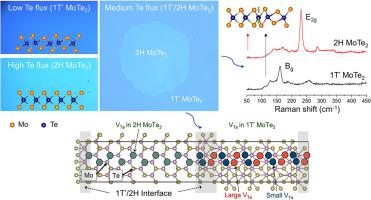当前位置:
X-MOL 学术
›
Surf. Interfaces
›
论文详情
Our official English website, www.x-mol.net, welcomes your
feedback! (Note: you will need to create a separate account there.)
Elucidating atomistic mechanisms of the formation of phase-controlled ultrathin MoTe2 films and lateral hetero-phase MoTe2 interfaces
Surfaces and Interfaces ( IF 5.7 ) Pub Date : 2023-06-14 , DOI: 10.1016/j.surfin.2023.103040 Hyeonkyeong Kim , Jooyong Bhang , Taejoon Park , Jae-Hyun Lee , Hosung Seo , Youngdong Yoo
Surfaces and Interfaces ( IF 5.7 ) Pub Date : 2023-06-14 , DOI: 10.1016/j.surfin.2023.103040 Hyeonkyeong Kim , Jooyong Bhang , Taejoon Park , Jae-Hyun Lee , Hosung Seo , Youngdong Yoo

|
Molybdenum ditelluride (MoTe) is gaining great attention because of its phase tunability. However, the precise control of the phase of ultrathin MoTe films is quite challenging, and the atomistic mechanism has not been fully elucidated. Here, we establish phase-controlled growth of ultrathin MoTe films by independently adjusting the Te atomic flux. We employed a chemical vapor deposition method that uses Mo nanolayers as a precursor to synthesize ultrathin MoTe films with a thickness of 4 − 7 nm. We found that ultrathin 1T’ MoTe films were formed with low Te atomic flux, whereas ultrathin 2H MoTe films were obtained with high Te atomic flux. Lateral metal–semiconductor hetero-phase 1T’/2H MoTe ultrathin films with seamless interfaces were synthesized with medium Te atomic flux. Furthermore, we performed density functional theory calculations to elucidate the detailed mechanisms of the phase transition between 1T’ and 2H MoTe driven by Te vacancy as well as the property of the 1T’/2H MoTe interface. This work provides a full understanding of the formation of phase-controlled ultrathin MoTe films and lateral metal–semiconductor hetero-phase MoTe interfaces.
中文翻译:

阐明相控超薄MoTe2薄膜和横向异相MoTe2界面形成的原子机制
二碲化钼(MoTe)因其相位可调性而受到广泛关注。然而,超薄MoTe薄膜的相的精确控制相当具有挑战性,并且原子机制尚未完全阐明。在这里,我们通过独立调节 Te 原子通量建立了超薄 MoTe 薄膜的相控生长。我们采用化学气相沉积方法,以 Mo 纳米层为前驱体,合成厚度为 4-7 nm 的超薄 MoTe 薄膜。我们发现超薄 1T' MoTe 薄膜是在低 Te 原子通量下形成的,而超薄 2H MoTe 薄膜是在高 Te 原子通量下形成的。采用中等Te原子通量合成了具有无缝界面的横向金属-半导体异相1T'/2H MoTe超薄膜。此外,我们还进行了密度泛函理论计算,以阐明Te空位驱动的1T'和2H MoTe之间相变的详细机制以及1T'/2H MoTe界面的性质。这项工作提供了对相控超薄 MoTe 薄膜和横向金属-半导体异相 MoTe 界面形成的全面理解。
更新日期:2023-06-14
中文翻译:

阐明相控超薄MoTe2薄膜和横向异相MoTe2界面形成的原子机制
二碲化钼(MoTe)因其相位可调性而受到广泛关注。然而,超薄MoTe薄膜的相的精确控制相当具有挑战性,并且原子机制尚未完全阐明。在这里,我们通过独立调节 Te 原子通量建立了超薄 MoTe 薄膜的相控生长。我们采用化学气相沉积方法,以 Mo 纳米层为前驱体,合成厚度为 4-7 nm 的超薄 MoTe 薄膜。我们发现超薄 1T' MoTe 薄膜是在低 Te 原子通量下形成的,而超薄 2H MoTe 薄膜是在高 Te 原子通量下形成的。采用中等Te原子通量合成了具有无缝界面的横向金属-半导体异相1T'/2H MoTe超薄膜。此外,我们还进行了密度泛函理论计算,以阐明Te空位驱动的1T'和2H MoTe之间相变的详细机制以及1T'/2H MoTe界面的性质。这项工作提供了对相控超薄 MoTe 薄膜和横向金属-半导体异相 MoTe 界面形成的全面理解。

































 京公网安备 11010802027423号
京公网安备 11010802027423号